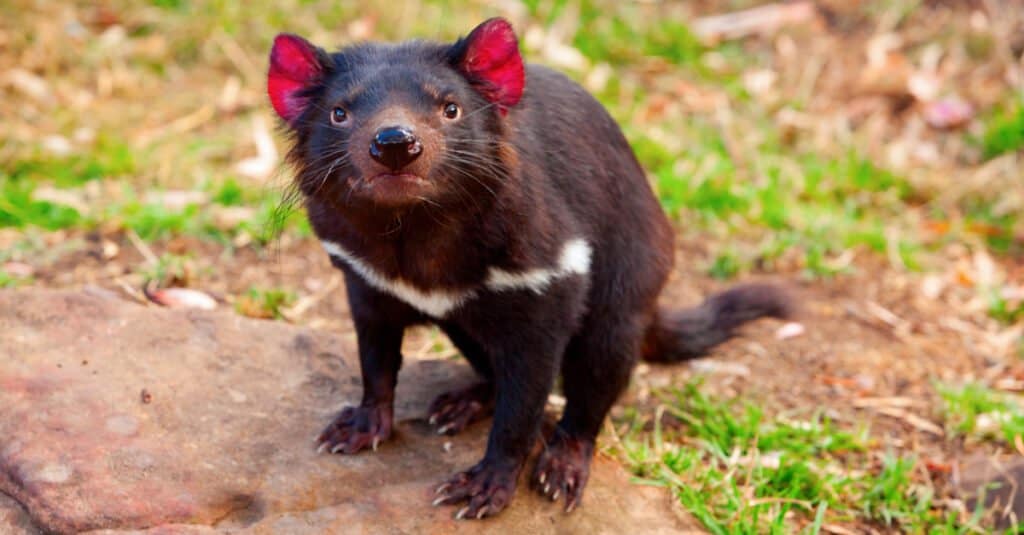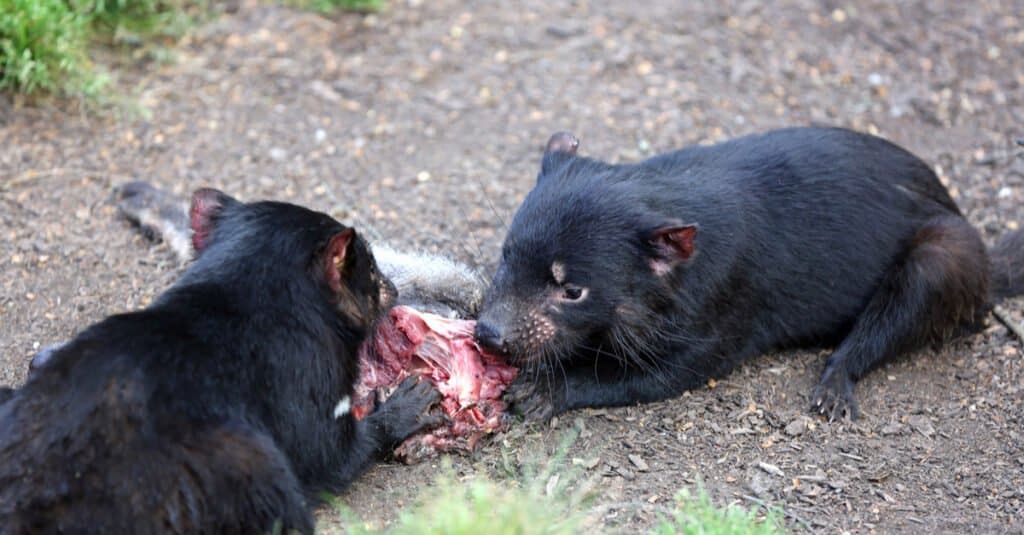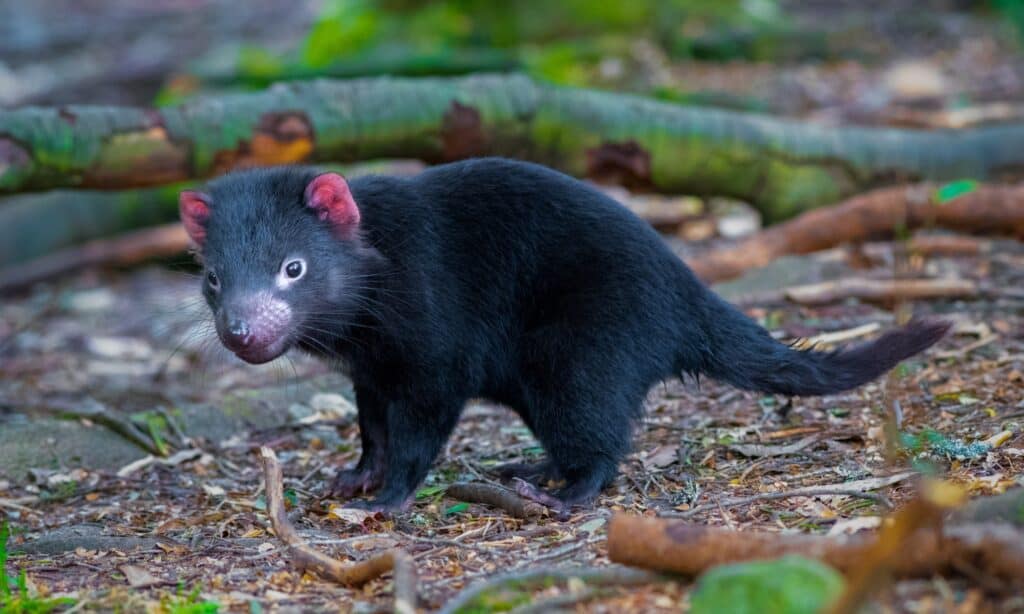Tasmanian devils may have been made popular by the character Taz in the Looney Tunes cartoon, but the real animals are not exactly like Taz. These nocturnal marsupials are unique and interesting animals. Therefore, we have compiled 10 incredible and enlightening facts about them that you should know.
1. Tasmanian devils hold the title of the largest carnivorous marsupials in the world

Tasmanian devils are the largest carnivorous marsupials in the world.
©Oleksii G/Shutterstock.com
These creatures weigh between 9 pounds (144 oz) and 29 pounds (464 oz) and are 20 to 31 inches long, making them the largest carnivorous marsupials in the world. Interestingly, until about 80 years ago, they were only the second largest. However, they moved into the number one spot when the thylacine, which held the top spot, became extinct. The last thylacine, or Tasmanian tiger, died in 1936. There have been rumors of supposed sightings of the Tasmanian tiger. However, it is generally agreed that the creature has disappeared from the world forever, leaving its throne to the Tasmanian devil.
2. The Tasmanian devil has an interesting story behind its name
The Tasmanian devil was named “devil” by early settlers who were quite certain that the devil either lived in or had a relationship with this animal. They arrived at this conclusion because of the maniacal rage the Tasmanian devil went into whenever it was defending food, looking for a mate, or feeling threatened by a predator. This rage was also characterized by loud, blood-curdling shrieks in the dark hours of the day. With all these, it didn’t take time for early settlers to begin referring to the animal as the devil.
In fact, baby Tasmanian devils are called imps, which in European folklore are demons or devils.
3. Tasmanian devils have the most powerful bite of any mammal alive

Relative to body size, the Tasmanian devil has the most powerful bite of any living mammalian carnivore today.
©Bernhard Richter/Shutterstock.com
Scientists have discovered that, relative to body size, the Tasmanian devil has the most powerful bite of any living mammalian carnivore today. The jaws of this animal can open as wide as 80 degrees, therefore allowing it to generate a lot of power behind its bite to tear through flesh and crush bones. Its bite is recorded to be powerful enough to allow it to bite through thick metal wires.
The power behind this animal’s jaws is related to the fact that it has quite a large head.
4. Tasmanian devils store fat in their tails
Generally, marsupials store fat in their tails, and the Tasmanian devil is not an exception. Storing fat in the tail ensures that they have a source of sustenance in the event that food becomes scarce. Usually, the size of a Tasmanian devil’s tail is an indication of how good it is doing. Therefore, plump tails are a good indication that the animal is doing quite well.
5. Tasmanian devils are endangered by cancer
Tasmanian devils are listed as an endangered species by the International Union for Conservation of Nature (IUCN), and the major reason for this is a rare kind of cancer that has killed about 80% of the population. This cancer, called “devil facial tumor disease” (DFTD), is contagious and spreads among the species when they bite each other during mating or fighting. The cancer causes large lesions on the face and neck of a Tasmanian devil that eventually expands to prevent the animal’s ability to eat. This leads to weakness and death, usually as a result of starvation.
Apart from the enormous death that is caused by this disease, the Tasmanian devil is also endangered as a result of killings by vehicles and dogs.
6. Tasmanian devils today are native to only Tasmania, but they once inhabited the whole of Australia

Fossil records show that at some point, Tasmanian devils were “Australian devils” too.
©james_stone76/Shutterstock.com
As their name suggests, these creatures may be found natively in Tasmania today, but fossil records show that at some point, they were “Australian devils” too. According to fossil records, these creatures vanished from the rest of Australia some 3000 years ago because of the arrival of dingoes about 500 years before that. Due to dingoes outcompeting Tasmanian devils, the creatures were eliminated. Climate changes and human pressure did not help as well. However, these creatures were reintroduced to the Australian mainland in 2021.
7. Tasmanian devils have very aggressive sex
These animals are very aggressive in their sex lives and engage in battles for dominance and supremacy. Generally, female Tasmanian devils love to mate with the strongest and most dominant males. Therefore, males usually have to fight to decide who will have them. Interestingly, defeating all the other males may still not be enough for the female to accept the male. The male must prove that he can dominate the female through physical force before she allows him to mate.
Usually, the male Tasmanian devil will bite the scruff of the neck of the female and drag her back to his den to mate with her. They mate for a couple of minutes to over an hour. To ensure that the female gives birth to his child, the male may prevent her from leaving his den until she is no longer fertile, but a good number of times, the female escapes and finds another mate.
8. Tasmanian devils are not dangerous to human beings
This should be reliving, considering the fact that they have incredibly powerful jaws. Generally, they avoid humans and will not attack one. Furthermore, contrary to a belief that led them to be poisoned and hunted, they do not attack cattle and livestock.
9. Baby Tasmanian devils are very small

Baby Tasmanian devils are as small as a grain of rice.
©iStock.com/Satheesh Rajh Rajagopalan
The babies delivered by female Tasmanian devils are as small as a grain of rice. They are incredibly tiny and are raised in their mother’s pouches for about four months before they move to the den. They reach full maturity after about 2 years.
10. Tasmanian devils can eat up to 40% of their body weight
Usually, these creatures eat up to 20% of their body weight, typically about four pounds of food. However, on days when food is scarce, they may eat as much as 40% of their body weight at once to ensure that they have a buffer in case they don’t find food anytime soon.
The photo featured at the top of this post is © james_stone76/Shutterstock.com
Thank you for reading! Have some feedback for us? Contact the AZ Animals editorial team.






